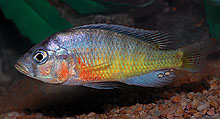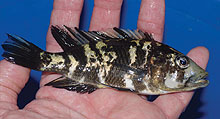WHAT'S NEW ACROSS THE WORLD
Select date in side bar to go to a What's New of previous issues
| What's New
©by Laif DeMason
Often people ask, where is the best place to find photos or information on cichlids? I always direct them to books by noted authors such as Ad Konings. Apparently many hobbyists do not obtain their information this way. They seem to use a variety of web sites, cichlid forums, or “You Tube” videos. Generally the information is not consistent and I am asked to decide what is the most correct. I generally favor web sites that have information by the noted authors and experienced experts. Soon the annual American Cichlid Association will be held in Denver, Colorado this July. Maybe it is best to get your information from the experienced cichlid enthusiasts in person!
Here’s “what’s new” on the cichlid scene: |
Lake Tanganyika
Collections of wild material seem to be coming in from all sides of Lake Tanganyika lately. A few of the older and more experienced divers are back to work collecting some of the not so often seen delicate cichlids, such as Cyprichromis and Xenotilapia species. This is a refreshing change from usual import selections of only the hardiest species such as Tropheus and the like.
|
WHAT'S NEW: LAKE TANGANYIKA
|
 One of the newly re-imported fish was formerly known as Cyprichromis sp. ‘yellow jumbo’. This cichlid has now been described as C. coloratus. This large ‘cyp’ can be a four full inches or more as a wild individual. A real beauty that needs several weeks in an aquarium to show its full colors best. Photo by A. Konings.
One of the newly re-imported fish was formerly known as Cyprichromis sp. ‘yellow jumbo’. This cichlid has now been described as C. coloratus. This large ‘cyp’ can be a four full inches or more as a wild individual. A real beauty that needs several weeks in an aquarium to show its full colors best. Photo by A. Konings.
|
 I sometimes order Tropheus ‘Golden Kazumbe’ from Zambian collectors. They usually arrive looking like what I used to call T. moorii Kachese, a somewhat orangey rainbow type. Recently we received some that look a bit different, pictured here. This could be a distinct form, likely caught east of Cape Kachese, but west of Nsumbu. The exact collection point is unknown.
I sometimes order Tropheus ‘Golden Kazumbe’ from Zambian collectors. They usually arrive looking like what I used to call T. moorii Kachese, a somewhat orangey rainbow type. Recently we received some that look a bit different, pictured here. This could be a distinct form, likely caught east of Cape Kachese, but west of Nsumbu. The exact collection point is unknown.
|
 Many of the Eretmodus sp. ‘north’ from collection points of Kigoma and southwards are orange or reddish in color. Recently imported, a group reportedly from Cape Kabogo, Tanzania is a bit redder than most. It is unknown whether this hue will fade in captivity or be enhanced with prepared foods with good carotene content.
Many of the Eretmodus sp. ‘north’ from collection points of Kigoma and southwards are orange or reddish in color. Recently imported, a group reportedly from Cape Kabogo, Tanzania is a bit redder than most. It is unknown whether this hue will fade in captivity or be enhanced with prepared foods with good carotene content.
|
 Last February, I saw for the first time a fish reported to have been developed by Czech breeders: a Cyphotilapia frontosa without bars! I’ve heard about this fish for some years but never had seen it. This weird monstrosity is apparently attractive to some. No need to worry about breeding fish with straight bars here!
Last February, I saw for the first time a fish reported to have been developed by Czech breeders: a Cyphotilapia frontosa without bars! I’ve heard about this fish for some years but never had seen it. This weird monstrosity is apparently attractive to some. No need to worry about breeding fish with straight bars here!
|
Lake Malawi
A new motto in the Malawi cichlid world: If it has color it will sell. Never mind which strain of fish you choose, color is king! And of course with color, price is important. So forget pricey wild caught fish with color; the only wild fish sold now are exclusive predatory or seasonal haplochromine species that appeal to the real Malawi connoisseurs.

Sporadically bred here and there by Europeans for decades from just a few shipments of limited individuals, Copadichromis virginalis ‘Firecrest’ is now being produced on fish farms. Photo by F. Callegari.
|

A rare find. This Labidochromis caeruleus was reportedly collected in Ruarwe, Malawi, and exported to Europe first a few years ago. This form seems to be colored with a deeper orange hue than the normal yellow strains.
|

Although demand is somewhat low over the last few years in the USA, Europeans actively seek OB morph mbuna like this Labeotropheus fuelleborni ‘Marmalade Cat’. Quite rare in the wild, these OB colored males can be actively produced by professional breeders, however.
|

Some of these OB fish can be collected in the wild, but OB females always outnumber their male counterparts. Pictured here: Metriaclima callainos Makonde, Tanzania. This place is where numerous OB fish of this species can be found. Photo by A. Konings.
|
Lake Victoria
Excitement grew when two quick collections were accomplished near Mwanza, Tanzania in Lake Victoria. Unfortunately, logistics and economics were not good and new collections seem unlikely. However, many new cichlids are now in the hobby and hopefully some of these will now breed and become available to hobbyists at some point.
|
WHAT'S NEW: LAKE VICTORIA
|

Collected at Juma Island, Tanzania, Paralabidochromis sp. ‘rock kribensis’ is one of the several species offered as wild-caught. It will be good to inject the current captive gene pool with new blood and vigor, so sadly needed for the bred strains of Victorian Basin cichlids.
|

Also among these wild collections from January, a few piebald fishes arrived. Some were scraper types with both males and females; however some look more like Paralabidochromis chromogynos, males only. If true, it would be the first new wild forms of that species to be imported in decades. It could be another species.
|
Select date in side bar to go a What's New of previous issues |
 One of the newly re-imported fish was formerly known as Cyprichromis sp. ‘yellow jumbo’. This cichlid has now been described as C. coloratus. This large ‘cyp’ can be a four full inches or more as a wild individual. A real beauty that needs several weeks in an aquarium to show its full colors best. Photo by A. Konings.
One of the newly re-imported fish was formerly known as Cyprichromis sp. ‘yellow jumbo’. This cichlid has now been described as C. coloratus. This large ‘cyp’ can be a four full inches or more as a wild individual. A real beauty that needs several weeks in an aquarium to show its full colors best. Photo by A. Konings.
 I sometimes order Tropheus ‘Golden Kazumbe’ from Zambian collectors. They usually arrive looking like what I used to call T. moorii Kachese, a somewhat orangey rainbow type. Recently we received some that look a bit different, pictured here. This could be a distinct form, likely caught east of Cape Kachese, but west of Nsumbu. The exact collection point is unknown.
I sometimes order Tropheus ‘Golden Kazumbe’ from Zambian collectors. They usually arrive looking like what I used to call T. moorii Kachese, a somewhat orangey rainbow type. Recently we received some that look a bit different, pictured here. This could be a distinct form, likely caught east of Cape Kachese, but west of Nsumbu. The exact collection point is unknown.
 Many of the Eretmodus sp. ‘north’ from collection points of Kigoma and southwards are orange or reddish in color. Recently imported, a group reportedly from Cape Kabogo, Tanzania is a bit redder than most. It is unknown whether this hue will fade in captivity or be enhanced with prepared foods with good carotene content.
Many of the Eretmodus sp. ‘north’ from collection points of Kigoma and southwards are orange or reddish in color. Recently imported, a group reportedly from Cape Kabogo, Tanzania is a bit redder than most. It is unknown whether this hue will fade in captivity or be enhanced with prepared foods with good carotene content.
 Last February, I saw for the first time a fish reported to have been developed by Czech breeders: a Cyphotilapia frontosa without bars! I’ve heard about this fish for some years but never had seen it. This weird monstrosity is apparently attractive to some. No need to worry about breeding fish with straight bars here!
Last February, I saw for the first time a fish reported to have been developed by Czech breeders: a Cyphotilapia frontosa without bars! I’ve heard about this fish for some years but never had seen it. This weird monstrosity is apparently attractive to some. No need to worry about breeding fish with straight bars here!





